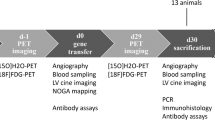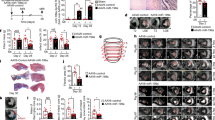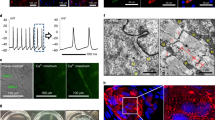Abstract
We previously reported adenovirus-mediated ex vivo gene transfer of basic fibroblast growth factor (bFGF) as a new treatment for leg ischemia. This time, we tested this method on a swine myocardial ischemia model, seeking the possibility of its application for ischemic heart disease. An ameroid constrictor was placed around the proximal left circumflex branch of pigs to induce myocardial ischemia. Simultaneously, a skin section was harvested and fibroblasts were cultured. Fibroblasts were then infected with adenovirus vector containing a bFGF cDNA with a secretory signal sequence (bFGF group, n=8) or a LacZ cDNA (control group, n=8). At 28 days after constrictor implantation, 2.5 × 106 fibroblasts were administered into each of the right and left coronary arteries. The injected fibroblasts accumulated in the myocardium without causing myocardial ischemia. Echocardiography, electromechanical mapping and coronary arteriography were conducted just before and 28 days after fibroblast injection, and regional left ventricular myocardial blood flow was measured 28 days after fibroblast injection. These evaluations revealed that the bFGF group exhibited significant development of collateral vessels and improvement of myocardial contraction in the ischemic area compared with the control group. We believe that this method is a promising treatment strategy for ischemic heart disease.
This is a preview of subscription content, access via your institution
Access options
Subscribe to this journal
Receive 12 print issues and online access
$259.00 per year
only $21.58 per issue
Buy this article
- Purchase on Springer Link
- Instant access to full article PDF
Prices may be subject to local taxes which are calculated during checkout








Similar content being viewed by others
References
Yanagisawa-Miwa A et al. Salvage of infarcted myocardium by angiogenic action of basic fibroblast growth factor. Science 1992; 257: 1401–1403.
Banai S et al. Angiogenic-induced enhancement of collateral blood flow to ischemic myocardium by vascular endothelial growth factor in dogs. Circulation 1994; 89: 2183–2189.
Losordo DW et al. Gene therapy for myocardial angiogenesis: initial clinical results with direct myocardial injection of phVEGF165 as sole therapy for myocardial ischemia. Circulation 1998; 25: 2800–2804.
Vale PR et al. Randomized, single-blind, placebo-controlled pilot study of catheter-based myocardial gene transfer for therapeutic angiogenesis using left ventricular electromechanical mapping in patients with chronic myocardial ischemia. Circulation 2001; 103: 2138–2143.
Ohara N et al. Adenovirus-mediated ex vivo gene transfer of basic fibroblast growth factor promotes collateral development in a rabbit model of hind limb ischemia. Gene Therapy 2001; 8: 837–845.
Suzuki K et al. Development of a novel method for cell transplantation through the coronary artery. Circulation 2000; 102(Suppl III): 359–364.
Lee RJ et al. VEGF gene delivery to myocardium: deleterious effects of unregulated expression. Circulation 2000; 102: 898–901.
Miyake S et al. Efficient generation of recombinant adenoviruses using adenovirus DNA-terminal protein complex and a cosmid bearing the full-length virus genome. Proc Natl Acad Sci USA 1996; 93: 1320–1324.
Akimoto M et al. Adenovirally expressed basic fibroblast growth factor rescues photoreceptor cells in RCS rats. Invest Ophthalmol Vis Sci 1999; 40: 273–279.
Sasada R et al. Expression of modified bFGF cDNAs in mammalian cells. Ann NY Acad Sci 1991; 638: 149–160.
Koyama H, Reidy MA . Reinjury of arterial lesions induces intimal smooth muscle cell replication that is not controlled by fibroblast growth factor 2. Circ Res 1997; 80: 408–417.
Ben-Haim SA et al. Nonfluoroscopic, in vivo navigation and mapping technology. Nat Med 1996; 2: 1393–1395.
Gepstein L, Hayam G, Ben-Haim SA . A novel method for nonfluoroscopic catheter-based electroanatomical mapping of the heart: in vitro and in vivo accuracy results. Circulation 1997; 95: 1611–1622.
Rentrop KP et al. Changes in collateral channel filling immediately after controlled coronary artery occlusion by an angioplasty balloon in human subjects. J Am Coll Cardiol 1985; 5: 587–592.
Acknowledgements
This study was supported by a Grant-in Aid for Scientific Research from the Ministry of Education, Culture, Sports, Science and Technology of Japan. We thank Yasuo Ohashi, PhD (Professor of Biostatistics, School of Health Sciences and Nursing, University of Tokyo) for statistical advice.
Author information
Authors and Affiliations
Rights and permissions
About this article
Cite this article
Ninomiya, M., Koyama, H., Miyata, T. et al. Ex vivo gene transfer of basic fibroblast growth factor improves cardiac function and blood flow in a swine chronic myocardial ischemia model. Gene Ther 10, 1152–1160 (2003). https://doi.org/10.1038/sj.gt.3301984
Received:
Accepted:
Published:
Issue Date:
DOI: https://doi.org/10.1038/sj.gt.3301984



